The cloudinids, an early metazoan family containing the genera Acuticocloudina, Cloudina and Conotubus, lived in the late Ediacaran period about 550 million years ago. and became extinct at the base of the Cambrian. They formed millimetre-scale conical fossils consisting of calcareous cones nested within one another; the appearance of the organism itself remains unknown. The name Cloudina honors the 20th-century geologist and paleontologist Preston Cloud.
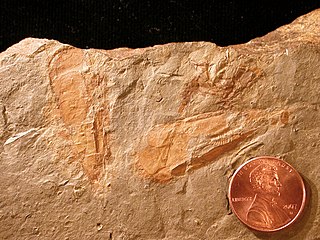
Hyoliths are animals with small conical shells, known as fossils from the Palaeozoic Era. They are at least considered as lophotrochozoan, and possibly belongs to lophophorates, a group which includes the brachiopods, while others consider it as basal lophotrochozoan, or even mollusc.
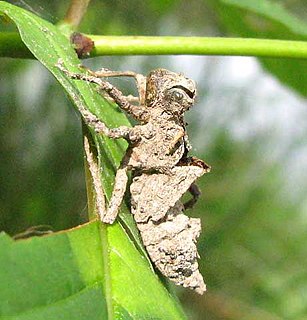
An exoskeleton is the external skeleton that supports and protects an animal's body, in contrast to the internal skeleton (endoskeleton) of, for example, a human. In usage, some of the larger kinds of exoskeletons are known as "shells". Examples of exoskeletons within animals include the arthropod exoskeleton shared by chelicerates, myriapods, crustaceans, and insects, as well as the shell of certain sponges and the mollusc shell shared by snails, clams, tusk shells, chitons and nautilus. Some animals, such as the turtle, have both an endoskeleton and an exoskeleton.
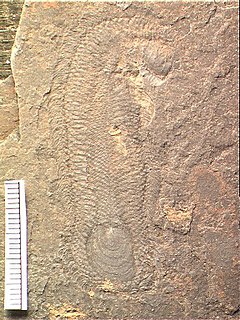
The halkieriids are a group of fossil organisms from the Lower to Middle Cambrian. Their eponymous genus is Halkieria, which has been found on almost every continent in Lower to Mid Cambrian deposits, forming a large component of the small shelly fossil assemblages. The best known species is Halkieria evangelista, from the North Greenland Sirius Passet Lagerstätte, in which complete specimens were collected on an expedition in 1989. The fossils were described by Simon Conway Morris and John Peel in a short paper in 1990 in the journal Nature. Later a more thorough description was undertaken in 1995 in the journal Philosophical Transactions of the Royal Society of London and wider evolutionary implications were posed.
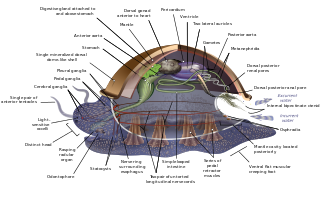
The evolution of the molluscs is the way in which the Mollusca, one of the largest groups of invertebrate animals, evolved. This phylum includes gastropods, bivalves, scaphopods, cephalopods, and several other groups. The fossil record of mollusks is relatively complete, and they are well represented in most fossil-bearing marine strata. Very early organisms which have dubiously been compared to molluscs include Kimberella and Odontogriphus.
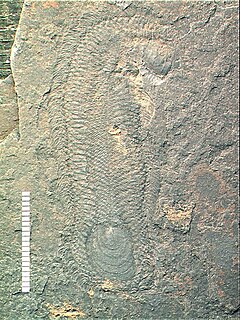
Halwaxiida or halwaxiids is a proposed clade equivalent to the older orders Sachitida He 1980 and Thambetolepidea Jell 1981, loosely uniting scale-bearing Cambrian animals, which may lie in the stem group to molluscs or lophotrochozoa. Some palaeontologists question the validity of the Halwaxiida clade.

Shelly limestone is a highly fossiliferous limestone, composed of a number of fossilized organisms such as brachiopods, bryozoans, crinoids, sponges, corals and mollusks. It varies in color, texture and hardness. Coquina is a poorly indurated form of shelly limestone.
A number of assemblages bear fossil assemblages similar in character to that of the Burgess Shale. While many are also preserved in a similar fashion to the Burgess Shale, the term "Burgess Shale-type fauna" covers assemblages based on taxonomic criteria only.

Helcionellid or Helcionelliformes is an order of small fossil shells that are universally interpreted as molluscs, though no sources spell out why this taxonomic interpretation is preferred. These animals are first found about 540 to 530 million years ago in the late Nemakit-Daldynian age, which is the earliest part of the Cambrian period. A single species persisted to the Early Ordovician. These fossils are component of the small shelly fossils (SSF) assemblages.
The small shelly fauna, small shelly fossils (SSF), or early skeletal fossils (ESF) are mineralized fossils, many only a few millimetres long, with a nearly continuous record from the latest stages of the Ediacaran to the end of the Early Cambrian Period. They are very diverse, and there is no formal definition of "small shelly fauna" or "small shelly fossils". Almost all are from earlier rocks than more familiar fossils such as trilobites. Since most SSFs were preserved by being covered quickly with phosphate and this method of preservation is mainly limited to the late Ediacaran and early Cambrian periods, the animals that made them may actually have arisen earlier and persisted after this time span.

Fordilla is an extinct genus of early bivalves, one of two genera in the extinct family Fordillidae. The genus is known solely from Early Cambrian fossils found in North America, Greenland, Europe, the Middle East, and Asia. The genus currently contains three described species, Fordilla germanica, Fordilla sibirica, and the type species Fordilla troyensis.
The cephalopods have a long geological history, with the first nautiloids found in late Cambrian strata, and purported stem-group representatives present in the earliest Cambrian lagerstätten.
The Mobergellidae are a family of small shelly fossils from the lower Cambrian. The small shells vary widely in shape, but are all bilaterally symmetrical discs with paired muscle scars radiating from the centre of the internal surface.
Pojetaia is an extinct genus of early bivalves, one of two genera in the extinct family Fordillidae. The genus is known solely from Early to Middle Cambrian fossils found in North America, Greenland, Europe, North Africa, Asia, and Australia. The genus currently contains two accepted species, Pojetaia runnegari, the type species, and Pojetaia sarhroensis, though up to seven species have been proposed. The genera Buluniella, Jellia, and Oryzoconcha are all considered synonyms of Pojetaia.

Fordillidae is an extinct family of early bivalves and one of two families in the extinct superfamily Fordilloidea. The family is known from fossils of early to middle Cambrian age found in North America, Greenland, Europe, the Middle East, Asia, and Australia. The family currently contains two genera, Fordilla and Pojetaia, each with up to three described species. Due to the size and age of the fossil specimens, Fordillidae species are included as part of the Turkish Small shelly fauna.

Fordilloidea is an extinct superfamily of early bivalves containing two described families, Fordillidae and Camyidae and the only superfamily in the order Fordillida. The superfamily is known from fossils of early to middle Cambrian age found in North America, Greenland, Europe, the Middle East, Asia, and Australia. Fordillidae currently contains two genera, Fordilla and Pojetaia each with up to three described species while Camyidae only contains a single genus Camya with one described species, Camya asy. Due to the size and age of the fossil specimens, Fordillidae species are included as part of the Turkish Small shelly fauna.
The orthothecids are one of the two hyolith orders.
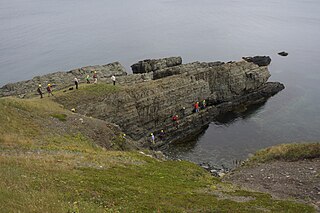
The Fortunian age marks the beginning of the Phanerozoic Eon, the Paleozoic Era, and the Cambrian Period. It is the first of the two stages of the Terreneuvian series. Its base is defined as the first appearance of the trace fossil Treptichnus pedum 538.8 million years ago. The top of the Fortunian which is the base of the Stage 2 of the Cambrian has not been formally defined yet, but will correspond to the appearance of an Archeocyatha species or "Small shelly fossils" approximately 529 million years ago.
Oymurania is an organophosphatic Cambrian small shelly fossil interpreted as a stem-group Brachiopod. It consists of a pair of Micrina-like shells that broadly follow a logarithmic coiling trajectory with a high rate of expansion.
Paracarinachites is a genus of sclerite-bearing creatures known from the early Cambrian period, originating around 530-520 Ma. They are often represented within the distinguished small shelly fauna (SSF) group because of their minuscule size-from only a few millimeters long, and because of their overt mineralized skeletons. Most SSF are from the clade Lophotrochozoa, however, it is unclear whether Paracarinachites are identified for certain as there have been rare cases of ecdysozoan SSF. Little is still known about the animal due to limited fossil collections; there are currently 27 known collections from China according to Fossilworks.








